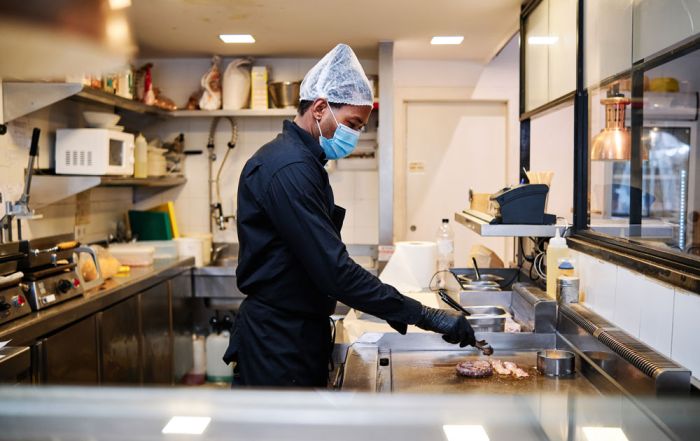Protecting Fresh Produce Post-Harvest, Integral to Safe Food
During the height of the summer, at least in the Midwest, farmers markets are in full swing and fresh produce is plentiful. Every backyard gardener is reaping the benefits of their work, with bountiful harvests of tomatoes and cucumbers. Everyone seems to have a neighbor who is trying to pawn off his or her over-production of cucumbers or summer squash during this time of year. When picking up that produce at the farmer’s market or from your neighbor down the street, have you ever given any thought to the microbial safety of it? Honestly, even in my position, it certainly is NOT the first thing that comes to my mind. But, earlier this month, I came across a news story out of Wisconsin discussing a Salmonella outbreak associated with shelled peas sold at a local farmers market. Who would have thought shelled peas would be impacted? The story noted, and it served as a great reminder, that most outbreaks associated with Salmonella in produce are due to mistakes made in handling or transportation of produce after harvesting.
If you are unfamiliar with Salmonella, check out a blog we did earlier this year that provided some information about the bacteria. In short, it accounts for almost a third of all food-related deaths in the United States each year, causing about 450 deaths yearly. Mild symptoms usually include diarrhea, fever, and abdominal cramps.
…we must also realize that what we do in our own gardens or homes cannot be the same practices we employ in our operations when feeding hundreds, if not thousands of guests per day – all with different immune system and food backgrounds than our own.
Proper handling of produce is vital to ensuring Salmonella or any one of the many foodborne illnesses does not grow to a level that it will case illnesses. First, be sure to order your produce from a reputable supplier. Working with a local farmer is perfectly acceptable. Certainly, having the Good Agricultural Practices or Good Handling Practices designation is good, but it is not required as long as they are following those practices on the farm.
When receiving fresh produce, be sure to check for quality and freshness. While there is no temperature requirement for whole fresh produce, be sure the quality is up to your standards and, even with the current issue we are having with supply chains, don’t feel pressured to accept a lower quality product.
When storing produce, be mindful of temperature and humidity, which can both impact shelf life. While many produce items do well at 32°F, some are cold sensitive and may require a higher temperature. To check the optimal storage conditions for fruits, vegetables, and herbs use free online resources from reputable authors. Our two favorite for fruits and vegetables are the fact sheets from Cornell University Cooperative Extension or the University of Maine.
I know…I know…it is fresh produce; how dangerous can it be? I am sure everyone reading this is thinking back to the time that they ate raw produce – fresh peas from the shell as you were picking them, corn off the cob as you were putting it up for the winter, or the crème de la crème for all gardeners – a fresh red, ripe tomato straight from the vine. I must admit, I have tried all of them and didn’t even wash them before consuming, and yet I live to tell the tale. However, we must also realize that what we do in our own gardens or homes cannot be the same practices we employ in our operations when feeding hundreds, if not thousands of guests per day – all with different immune system and food backgrounds than our own. Risk Nothing.
READ MORE POSTS
Don’t Underestimate the Importance of Employee Health as we head into the Winter Months
Early this month, I ran across an article discussing an outbreak investigation in the Australian Capital Territory. The outbreak caused more than 200 people to fall ill and was one of the most widespread outbreak investigations in the history of the territory. The cause was traced back to Norovirus, a virus I am sure you have heard us opine about in this blog before.
Exclusion and Restrictions: Understanding Employee Health and the Food Code
I received a call earlier in the month from a foodservice operator who suspected that one of their employees may have fallen ill and wondered if they had to send the employee home for the day. Once I started to ask a few more questions, it became obvious that the operator wasn’t really in-tune with the food code requirements on restrictions or exclusions for employees who may not be feeling well. Given that most operations are dealing with staff shortages currently and the fact that we are about to head into the fall and winter – when we tend to see an increase in upper respiratory and other illnesses, such as the flu - it seemed like a very timely and important topic for the blog this month.
Cross Contamination and the Surfaces that go Unnoticed
In October, I ran across a new research study published in the Journal of Food Protection in early-September. The article explored cross contamination in consumer kitchens during meal preparation. One of the authors was a previous SafeBites presenter, Dr. Ellen Shumaker, at North Carolina State University. Although the setting was consumer kitchens and not the commercial kitchen many of you deal with daily, the findings were very applicable to what we often see in the foodservice setting.
Emergency Preparedness: The Not-so Calm After the Storm
If you and your foodservice operation have been hit by an emergency or other disaster, what comes next and how do you move forward? Much of the answer to this is predicated on the actual disaster that you are dealing with – a flood is certainly a much different than a fire, but some of the food safety considerations remain the same if your business has been left intact and has not been damaged by the disaster.










